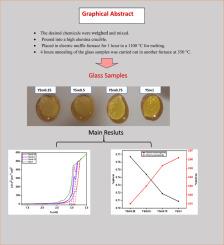通过掺杂不同浓度的钇和钐氧化物来增强硼酸盐玻璃的光学和伽马射线屏蔽特性
IF 5.7
3区 材料科学
Q2 MATERIALS SCIENCE, MULTIDISCIPLINARY
引用次数: 0
摘要
本研究研究了用PbO2和稀土掺杂剂Y2O3和Sm2O3增强硼酸盐玻璃的双光学和γ射线屏蔽目的。PbO2+Y2O3+Sm2O3含量的增加增加了材料的密度(3.937 ~ 4.536 g/cm3)和摩尔体积(25.929 ~ 26.529 cm3/mol),光学直接带隙减小3.126 ~ 2.931 eV,间接带隙减小2.764 ~ 2.529 eV,并提高了材料的折射率(2.443 ~ 2.503)。在0.015-10 MeV范围内,通过线性衰减系数(LACs)、有效原子序数(Zeff)和辐射防护效率(RPEs)来评估其γ射线屏蔽性能。最高掺杂玻璃(YSm1.0)的LAC降低了98.3%(光电)和93.41%(康普顿),优于RS 253。在0.2 MeV下,掺杂量的增加也会提高密度(3.937 ~ 4.536 g/cm3)、Zeff(53.891 ~ 60.572)和rpe(80.233 ~ 90.723%)。在1 MeV (0.25-3 cm)下,rpe从6.878%增加到57.479%,厚度增加增强了屏蔽效果。这些结果证实了ysm掺杂玻璃作为辐射屏蔽和光学应用的有前途的材料。本文章由计算机程序翻译,如有差异,请以英文原文为准。

Boosting the optical and gamma-ray shielding features of borate glasses by doping with various concentrations of yttrium and samarium oxides
This study investigates borate glass enhanced with PbO2 and rare-earth dopants Y2O3 and Sm2O3 for dual optical and γ-ray shielding purposes. Increasing the PbO2+Y2O3+Sm2O3 content increased the density (3.937–4.536 g/cm3) and molar volume (25.929–26.529 cm3/mol), while leading to a 3.126 to 2.931 eV optical direct band gap reduction and a 2.764 to 2.529 eV indirect band gap reduction, and raising the refractive index (2.443–2.503). The γ-ray shielding performance was evaluated via linear attenuation coefficients (LACs), effective atomic numbers (Zeff), and radiation protection efficiencies (RPEs) across 0.015–10 MeV. The highest doped glass (YSm1.0) showed LAC reductions of 98.3 % (photoelectric) and 93.41 % (Compton), outperforming RS 253. Increased dopant levels also raised density (3.937–4.536 g/cm3), Zeff (53.891–60.572), and RPEs (80.233–90.723 % at 0.2 MeV). Greater thickness enhanced shielding, with RPEs increasing from 6.878 % to 57.479 % at 1 MeV (0.25–3 cm). These results confirm YSm-doped glasses as promising materials for radiation shielding and optical applications.
求助全文
通过发布文献求助,成功后即可免费获取论文全文。
去求助
来源期刊

Materials Research Bulletin
工程技术-材料科学:综合
CiteScore
9.80
自引率
5.60%
发文量
372
审稿时长
42 days
期刊介绍:
Materials Research Bulletin is an international journal reporting high-impact research on processing-structure-property relationships in functional materials and nanomaterials with interesting electronic, magnetic, optical, thermal, mechanical or catalytic properties. Papers purely on thermodynamics or theoretical calculations (e.g., density functional theory) do not fall within the scope of the journal unless they also demonstrate a clear link to physical properties. Topics covered include functional materials (e.g., dielectrics, pyroelectrics, piezoelectrics, ferroelectrics, relaxors, thermoelectrics, etc.); electrochemistry and solid-state ionics (e.g., photovoltaics, batteries, sensors, and fuel cells); nanomaterials, graphene, and nanocomposites; luminescence and photocatalysis; crystal-structure and defect-structure analysis; novel electronics; non-crystalline solids; flexible electronics; protein-material interactions; and polymeric ion-exchange membranes.
 求助内容:
求助内容: 应助结果提醒方式:
应助结果提醒方式:


